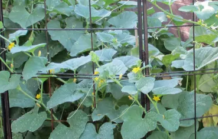We have had a number of instances of powdery mildew on lawns in eastern and southern Kansas. Though the disease looks serious, it rarely causes lasting damage to the turf.
Individual blades look like they have been dusted with flour.
Closer inspection reveals a white, powdery growth primarily on the upper surface of the leaves. As the disease progresses, turfgrass blades wither and die. Kentucky bluegrass grown in the shade is the most likely to be
affected though other species can be susceptible. High relative
humidity, poor air movement, and air temperatures around 65°F favor disease development. Try to improve light and air penetration.
The development of mildew often indicates areas of the lawn that are unsuitable for turfgrass. Consider other types of ground covers for these areas.
Several fungicides, including triadimefon (Bayleton), propiconazole (Banner MAXX, Fertilome Liquid Systemic Fungicide), and myclobutanil (Eagle, Immunox) are effective in reducing the incidence of powdery mildew. (Ward Upham)




